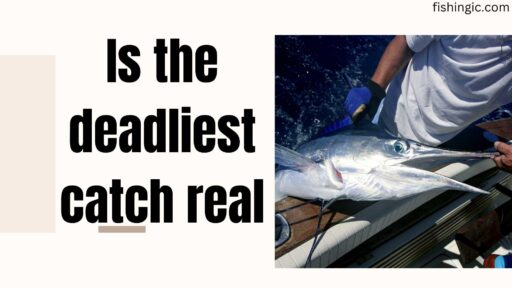Looking for a Fish Finder For Jet Ski? Browse our website for a wide selection of devices to help you locate fish with ease while out on the water.
Those who are passionate about jet skiing have always enjoyed the feeling of being in the middle of nowhere, riding waves where the sky meets the sea. But what has been changing everything for them recently is this high-tech gadget combined with their favorite water sport. Specifically, it’s about including Fish Finder For Jet Ski, which allows anglers to get access to fish-abundant waters like never before while still enjoying the freedom and mobility offered by jet skis.
Throughout this article, we will explore everything there is to know about using fish finders in jet ski fishing, from understanding these devices to buying one and becoming an angling master with its help!
Understanding The Fish Finder For Jet Ski
Before we look into details of how you can use a Fish Finder For Jet Ski when doing your fishing using a jet ski, let us first know its function and working principles. A fishfinger essentially refers to any electronic device that employs sonar technology in order to locate underwater objects such as schools of fish. It does this by emitting sound waves through water which then bounces back off these items and returns as readings onto the screen display where they are shown.
Common things displayed on screens include water depth measurements as well as presence & size indications, among others (fishes). Some advanced models may also incorporate mapping functions together with GPS features.
Advantages Of Using A Fish Finder In Jet Ski Fishing
Having understood what it does, let now move on to why people should consider having one for their next fishing expedition using a personal watercraft;
Enhanced Portability: With an installed fish finder system onto your personal watercraft, moving around becomes easier since you can cover more areas while searching for fishes within shortest time possible. This is particularly beneficial because traditional boats might not be able to enter certain shallow or narrow sections hence limiting chances.
Immediate Information: Another reason why having these devices is important lies in the fact that they give real-time data about fish locations. This enables users to make quick decisions on where they should cast their fishing lines.
Saves Time And Effort: These sonar units can help you save energy and hours of searching for fish by letting you know where exactly they are found.
Increases Catching Success Rate: In essence, this tool increases your chances of catching fish since it tells you where schools can be located easily.
Selecting The Best Fish Finder For Jet Ski Fishing
There are various considerations that one has when choosing a fish finder for use during jet ski fishing. The following tips will guide you in making the right decision;
- Compactness And Portability: Given that these items will be utilized on personal watercraft, it becomes necessary to select those that are small-sized and lightweight, thus not interfering with stability while riding.
- Waterproof Ability: When going out for long periods while jet skiing, always ensure that your chosen model is resistant to water damage caused by splashes or continuous exposure.
- Screen Visibility: Considering how fast a jet ski moves from place to place, it’s therefore prudent if one opts for those finders with bright clear screens readable under different light conditions.
- GPS and Mapping Features: If you want to visit new fishing locations, then it is recommended that you use a fish finder with GPS and mapping features for easy navigation in unfamiliar waters.
Tips on How to Use a Fish Finder When Jet Ski Fishing
Now that you have purchased the best fish finder for your jet ski fishing trips, here’s how to make the most out of it:
Before going out into the water, familiarize yourself with all the settings and features of your fish finder. This will save you a lot of time and frustration while trying to figure out how to operate it while also trying to catch fish.
Try using different frequencies so as to find which one works best for your specific fishing spot. For example higher frequencies work better in shallow areas while lower ones perform well in deeper parts.
Watch the screen closely for any signs of movement or changes such as schools of bait fish swimming by or something large appearing suddenly before disappearing again – these could be good signs that there are other bigger game species nearby waiting for their next meal!
Section One: Understanding Fish Finders
A Deeper Look Into How Fish Finders Work
Fish finders are a kind of sonar device that uses sound waves in order to ‘see’ what is underwater. These marine gadgets emit a sound pulse that bounces off objects in the water like fish, seabed, debris etc., and gives an image or reading back to its user. With now having high-definition displays that can map out underwater topography and highlight fishes around you, they have come quite far since their invention days. Having a fish finder on your jet ski can really add another dimension to those days spent out on the water, whether it’s casual fun time or a serious fishing trip for any water sports enthusiast or angler.
Different Types Of Fish Finders Available In The Market
Fish finders come in many shapes & sizes, from simple wired through hull units found on larger boats all the way down to portable units that are suitable for use with jet skis. Nowadays, most fish finders come with GPS, which not only allows for underwater mapping but also enables marking productive fishing spots for future reference. There is something out there designed specifically to cater to every budget and skill level, making it possible for anyone who wants to take their fishing game up a notch.
Section Two: Benefits Of Using A Fish Finder On A Jet Ski
An Unfair Advantage In Catching More Fish
It’s hard not to admire the unfair advantage that comes with having a fish finder. Imagine this – you’re cruising along on your jet ski, the wind blowing through your hair and sun warming your back; no need to guess where to cast because you know exactly where those fish are waiting! The data provided by these devices can lead to incredible catch rates as well as ensuring each move made in water is informed by intelligent information.
Increasing Safety While Out On Water Bodies
A fish finder does more than just help one land big ones; it also keeps them safe. By showing the depth of water, underwater currents, and temperature of different waters around us, fish finders mounted onto our jet skis could be said to provide us with ‘x-ray vision’ over what lies beneath, saving us from running aground or driving into hazardous areas unknowingly. This safety feature becomes most helpful when we venture into new waters during unpredictable weather conditions.
Every fishing style and budget can be met with a fish finder, and there are several important considerations that should affect your choice. Among the features you need to evaluate include the type of transducer, frequency options, display quality and power output. Low frequencies give a wider cone angle, ideal for deeper waters and larger fish, while high frequencies give a more detailed view of shallower waters and smaller bait. The transducer should match your fishing environment and mounting requirements as it sends out sonar signals.
Comparison of Top Models for Jet Ski Fishing
There are some units specifically built for jet ski use, which are ruggedly constructed to withstand this fast-paced sport’s unique demands and waterproofed against water splashes or sprays hitting them while moving at high speed over waves, such as Garmin Striker or Hummingbird Piranha Max series have become popular among these anglers due their versatility & ease-of-use features like screen resolution; target separation (ability distinguish between adjacent echoes on-screen); customization options such as color schemes etc., therefore evaluating these factors may ensure finding the right fit for your vessel.
Section Four: Installing and Using a Fish Finder on Your Jet Ski
Installing Your Fish Finder System
After purchasing the best fish finder that suits your jet ski model, its installation is the next step. Typically, it involves putting the transducer at the back of the watercraft where it will be immersed in water but not too low so as to avoid hitting objects or having effects on the performance of your machine. If you are drilling into any part of your PWC, then this process might not be suitable for you, especially if it’s your first time doing so;
thus, seeking professional assistance would come in handy in such cases since they have experience dealing with different types boats & personal watercrafts (PWCs). Use a marine-grade sealant to fill up all holes created during the installation process while fixing the display unit somewhere convenient yet secure enough not to block vision from the riding position.
Mastering The Art Of Jet Ski Fishing With A Fish Finder
So now that you have installed your fish finder on the jet ski, it’s time to go out there and put this new piece of technology through its paces. Use the GPS feature to map all your favorite fishing spots as well as take note of any underwater structures where fish may be found gathering at different times throughout the year, then continuously update yourself about such areas within local waters.
Practice moving around while scanning using different sensitivities so that once schools are spotted by the device, one can quietly move closer for a catch without scaring them away due to being too loud or fast in approach speed – with usage frequency should become good at finding fish using personal watercraft (PWC) equipped with fishfingers like professional.
FAQs
What is a Fish Finder for a Jet Ski?
A fishfingers for PWC is an electronic device designed specifically to help anglers find more catch by seeing what lies beneath surface level; they employ sonar technology which sends out sonar waves into water then interpret returning echoes into visual representation depicting underwater topography, objects including fishes etc.
How does the fish finder work on a jet ski?
The fish finder operates on a jet ski by using a transducer to send out sonar signals into the water. These signals bounce back to the transducer when they hit an object such as fish or the bottom. By calculating how long it takes for the echoes to return, which helps in determining the depth, shape and composition of an object; this information is then displayed on screen showing where fishes are located at as well as underwater structures.
Can any Fish Finder be used on a Jet Ski?
No, not all fish finders can be used on a jet ski. When choosing one for use on a personal watercraft like this it’s important that you consider its waterproofing ability against vibrations from riding over waves while also being compact enough not take up much space and easy enough to install quickly even if already out fishing some distance away from shore.
Conclusion of Fish Finder For Jet Ski
When it comes to mastering jet ski fishing with a Fish Finder For Jet Ski, it’s not only about the technology; it also involves skill, experience, and know-how mixed with the excitement of pursuit and satisfaction of achievement. Combining two amazing water activities – fishing and riding a jet ski – is pure magic made even better by modern innovations. If you are an enthusiastic rider who wants to up their game in angling, then this is the best time for you! Fish finders have many merits, from safety precautions to increasing catch rates; therefore, they are worthwhile additions to any vessel.
Jet ski fishing with a Fish Finder For Jet Ski is more than just an activity – it’s an adventure. And what’s more fun than sharing adventures? Get in touch with fellow riders or anglers, tell them your story and listen as they share their own tales. If you’re feeling brave enough, then maybe your next big catch could be one sonar ping away! Have a safe ride and always remember to keep your lines tight.






